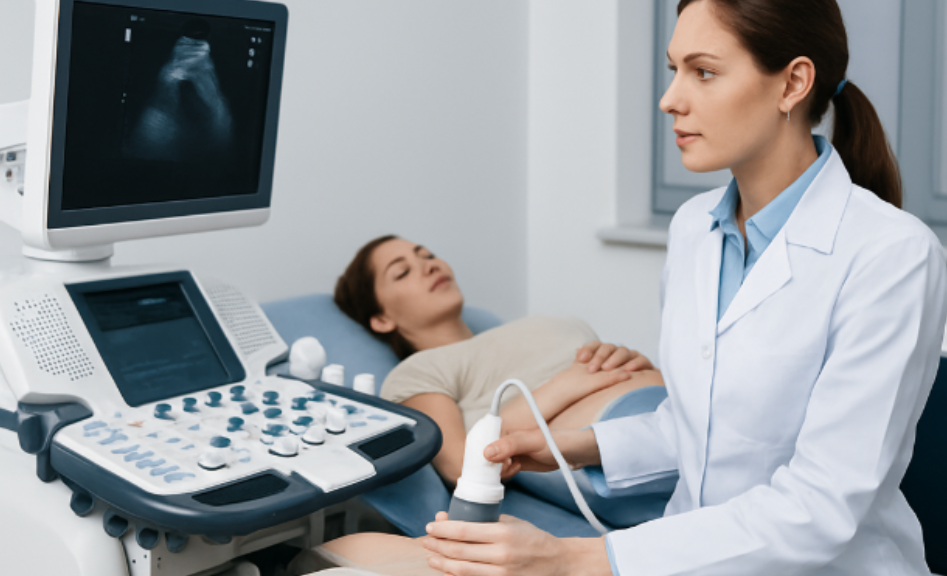Are your periods disorganized? one month late and then totally missing the next? Irregular menstrual cycles can be beyond just an inconvenience, they could be a sign PCOS, a common but still misunderstood hormonal disorder effecting so many women. One of the most efficient tools for detecting PCOS is an ultrasound, but do you know that timing play an important role in how authentic your results are? In this blog, we will discover the best time to do your ultrasound and also will shed light on how your menstrual cycle affects the detection.
What is PCOS?
PCOS or Polycystic Ovary Syndrome is a hormonal illness that disturbs people with ovaries, particularly during the age of reproduction. It is marked by excess testosterone levels, polycystic ovaries and irregular menstrual cycles where the ovaries might develop follicles (small fluid-filled sacs) and miss to routinely release eggs. The accurate cause is unknown but is connected to insulin resistance, hormonal imbalance and genetics. PCOS can be handled through medications, lifestyle changes and hormone therapy. Early detection and treatment aid in reducing the risk of complications like heart disease and diabetes.
PCOD vs PCOS: What is the Difference?
-
Polycystic Ovary Syndrome (PCOS) is a more extreme hormonal and metabolic disorder with long-term concerns like heart disease and diabetes.
-
Polycystic Ovarian Disease (PCOD) is less intense and common, often correlated to lifestyle factors and is easy to manage.
Why Use Ultrasound to Diagnose PCOS?
Ultrasound scanning helps doctors render the ovaries and examine whether they show hints of PCOM (polycystic ovarian morphology). PCOM is one of the three diagnostic criteria applied in the broadly accepted Rotterdam criteria for diagnosing PCOS:
-
Polycystic ovaries on ultrasound
-
High Testosterone levels
-
Absent ovulation or irregular
A Female should meet at least 2 of these criteria to be detected with PCOS
What kind of ultrasound to select for PCOS?
There are mainly two types of ultrasounds used to examine about PCOS:
-
TVUS (Transvaginal) Ultrasound: This is the exact method for detection. A probe is put into the vagina to get an intimate view of uterus and ovaries.
-
Transabdominal Ultrasound: It includes setting the probe on the abdomen and is generally used for the people who can’t go through a transvaginal scan, for example adolescents and virgins.

The Purpose of Menstrual Cycle in a Pelvic Ultrasound
Your period cycle affects your sexual organs in anticipated ways, which impact ultrasound results.
Initial Cycle (1-5 Days)
-
Perfect time to examine follicle count and ovarian volume.
-
Endometrium or uterine lining is thin, making uterine deviations easier to diagnose.
Mid-Cycle (10–14 Days)
-
More dominant follicles might develop and covering smaller cysts
-
Thus, it is not ideal for detecting PCOS
Closing Cycle (Post-ovulation)
-
Corpus luteum or Post-ovulatory follicle may be present, which can be similar to lump
-
Endometrial breadth increases, possibly concealing other findings
When Is the Best Time to Do an Ultrasound to Diagnose PCOS?
The most reliable time to go through a pelvic ultrasound to diagnose PCOS is on 2nd day to 5th day of your monthly menstrual cycle and that is during the early follicular phase. This time frame permits doctors to get a more transparent image of the ovaries and count the number of follicles, which is crucial for detecting PCOS.
Why? Because…
-
Hormones like LH and FSH are at benchmark, minimizing the interference
-
There is no prominent follicle yet, which can muddle results
-
The uterus lining is thin, giving a clearer image of pelvic anatomy
-
Ovarian volume and follicle count are most consistent in this phase
Frequently Asked Questions
Q1: Alone ultrasound can confirm PCOS?
A: No. Diagnosis generally includes a fusion of clinical symptoms, ultrasound findings and hormone level tests.
Q2: Is it mandatory to do PCOS ultrasound during periods?
A: No, it’s not in fact, it is often suggested to have the scan done a few days after your period has ended.
Q3: How frequently should ultrasounds be done for PCOS?
A: It should be done occasionally if you are undergoing fertility treatment or symptoms change.
Q4: What to expect during a PCOS ultrasound?
A: The Procedure includes:
-
You have to lie down on an examination table.
-
A cooling gel will be applied to your abdomen for the scan.
-
The doctor will move the probe to encapsulate the image.
-
If it is transvaginal, a concealed and lubricated probe will be inserted delicately for better inside views.
-
The ultrasound scan typically takes 10-15 minutes.
Conclusion
PCOS is a critical condition that needs consistent management and timely diagnosis. The best time to do an ultrasound to detect PCOS is in the time frame of the starting days of your menstrual cycle, leveraging a transvaginal ultrasound for correct follicle assessment. While there is no known way to cure PCOS permanently, a fusion of lifestyle adjustments and medical treatments can help manage it proficiently. At Niramaya neurospine & diagnostics centre our experienced gynecologists are available to provide personalized care and guidance. Assuring you get the help you need for better health.
Visit Niramaya today for expert advice and complete care on handling PCOS.




Leave A Comment